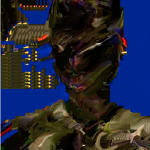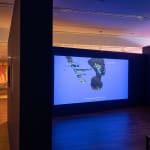-
Open a larger version of the following image in a popup:
 LONG LIVE THE NEW FLES$S$SH (INSTALLATION VIEW), 2020, Image courtesy of National Gallery Singapore
Open a larger version of the following image in a popup:
LONG LIVE THE NEW FLES$S$SH (INSTALLATION VIEW), 2020, Image courtesy of National Gallery Singapore
Open a larger version of the following image in a popup: LONG LIVE THE NEW FLES$S$SH (INSTALLATION VIEW), 2020, Image courtesy of National Gallery Singapore
LONG LIVE THE NEW FLES$S$SH (INSTALLATION VIEW), 2020, Image courtesy of National Gallery Singapore
Priyageetha Dia
LONG LIVE THE NEW FLES$S$SH, 2020Single channel video16:9 format, colour and sound (stereo), 4 min 30 secEdition of 3 plus 1 artist's proofCopyright The ArtistFurther images
The video works expand the possibilities for imagining brownness, imaging it into a digital consciousness. The works draw on the artist’s personal history while borrowing elements from Sandro Botticelli’s depiction of The Three Graces in Primavera (c.1470–1480) and Nicolas Provost’s Long live the new flesh (2009) to offer a recourse for the lack of representation of non-western identities and to flesh out newer narratives between utopian and dystopian imaginings. Confronting the romanticisms of Western Enlightenment thought, the works reconfigure and magnify the presence of the generic, femme-presenting Other through computer generated imagery and data-moshing techniques, inquiring the grounds on would it mean for marginalised identities to traverse into the matrix.
The title is an adaptation of Nicolas Provost’s film Long live the new flesh (2009) in which data moshing techniques is utilised to render a newer visual experience to films. Using that as a catalyst as a way to fragment the visual language of racial, gendered trauma by breaking, morphing, fracturing and compressing frames as an infinite failure to perform in reading the body in the machine - which is then presented against a blue screen of death.
Long live the new fles$s$sh is also encrypted with a poem. Referencing the writings of Legacy Russell’s Glitch Feminism, “Encryption…indicates the encoding of a message, rendering it unreadable or inaccessible to those unauthorised to decipher it. It reminds us that there are gaps and hidden histories, parts of the file that cannot be heard and stories that will never be known to certain audiences.”The title is an adaptation of Nicolas Provost’s film Long live the new flesh (2009) in which data moshing techniques is utilised to render a newer visual experience to films. Using that as a catalyst as a way to fragment the visual language of racial, gendered trauma by breaking, morphing, fracturing and compressing frames as an infinite failure to perform in reading the body in the machine - which is then presented against a blue screen of death. Long live the new fles$s$sh is also encrypted with a poem. Referencing the writings of Legacy Russell’s Glitch Feminism, “Encryption…indicates the encoding of a message, rendering it unreadable or inaccessible to those unauthorised to decipher it. It reminds us that there are gaps and hidden histories, parts of the file that cannot be heard and stories that will never be known to certain audiences.”
Exhibitions
Presented as part of An Exercise of Meaning in a Glitch Season, Part of Proposals of Novel Ways of Being (04 September 2020 to 21 February 2021. Curated by Syaheedah Iskandar. National Gallery Singapore, Singapore.




